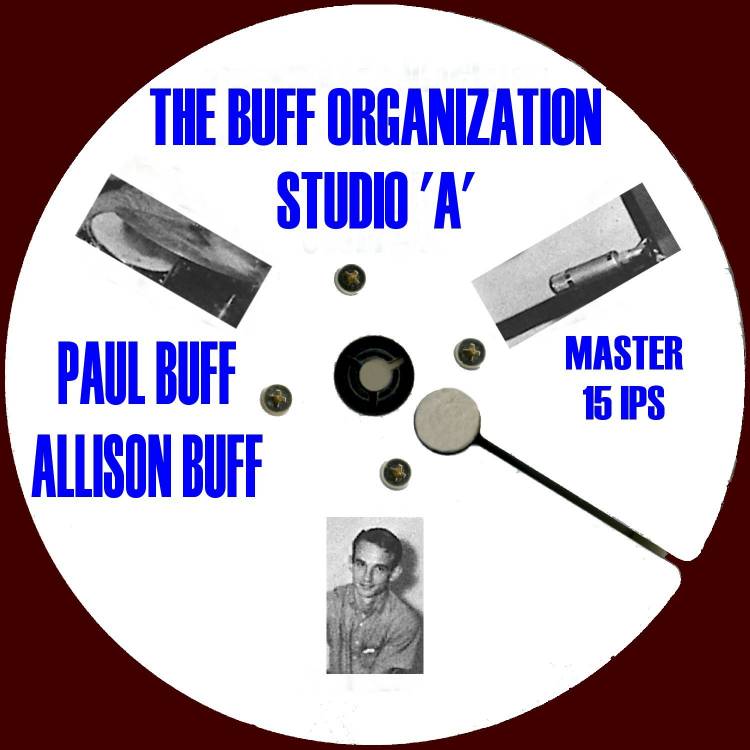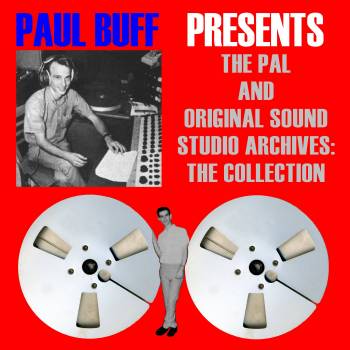

|
|
| (2010, download, - , crossfire publications) |
 |
| (2011, flash-drive, usa, crossfire publications) |
studio 'a'
| 2010 | download | - | crossfire publications |
re-releases
(2011,
flash-drive, usa, crossfire publications) =
the complete 35 album series, with bonus liner notes on pdf and 56 extra tracks
paul
buff
allison buff
you (sax/violin/percussion demo)
studio 'a'
groovy summer afternoon
fuzz instrumental
the land of in-between
chains
orchestral instrumental
upside down world
the parrot goose song
new theme
sunshine girl (full version)
you
the square
summer avenue
the land of in-between (piano/vibes/drums demo)
contemplate your life (version 1)
liner notes by Greg Russo:
The
Buff Organization released only one single during the '60s: "Studio
'A'"/ "Upside Down World" on Original Sound in 1968. However,
Paul Buff and his wife Allison recorded many tracks between 1964 and 1969 that
have not been released until now. Drawn from the original masters and work tapes
from Buff's archives, "Studio 'A'" is the album The Buff Organization
would have released at the time.
Paul
Buff was the owner of Pal Studios in Cucamonga, California from December 1957 to
August 1, 1964, when he sold Pal to Frank Zappa. Many of the tracks recorded at
Pal during this period are available on the 20-volume set "Paul Buff
Presents The Pal And Original Sound Studio Archives."
In
the spring of 1963, Paul Buff was asked by Original Sound owner and legendary DJ
Art Laboe to re-equip the label's studio. Buff completed the studio by the time
he sold Pal, and he was busy recording at Original Sound using many different
names. After this period, Paul and Allison Buff used just one name - The Buff
Organization - to market their more adventurous pop music.
At
the same time, Buff was engineering recordings at Original Sound by artists such
as The Music Machine and those signed to the All-American label created by Bill
Holmes. All-American artists tended to be more psychedelic with deluxe vocal
arrangements by hired vocal coach Frank Davis. This modern approach was
naturally filtered into The Buff Organization's sound. Today, this type of music
is known as "sunshine pop" or "soft psych," but regardless
of what box one places it in, The Buff Organization was part of that scene.
Paul
Buff likes to call himself a "song mechanic," working with the
different elements of a recording (arrangement, performance, effects, mixing,
etc.) to get the most out of a song. It is an approach he still uses today.
Numerous versions of each song were prepared until Buff was happy with the
results.
Late
1967 was a very fertile period for Paul and Allison Buff. "Studio 'A'"
was a satirical song about the recording process and how what happens in the
studio can lead to success. It liberally used phasing and '60s pop elements
along with vocals that harkened back to the doo-wop period to create a unique
song. The Buffs went through ten versions of "Studio 'A'" (nine in
mono, and one in stereo) before the mono single mix was released. The problem
was that the public didn't hear it for the most part, as the record got lost in
the sea of stellar releases in March 1968.
The
record's B-side, "Upside Down World," also required ten versions
before its eventual release. Originally titled "I Care For Her,"
"Upside Down World" started out as a demo with just piano and Paul
Buff's vocal. As Paul continued to work on the song, he hit upon an arrangement
that built up into one time signature after another. Buff worked lots of
different instruments into the mix, including his rare performance on viola.
Different vocal versions by Paul and then Allison Buff were tried until he
decided to go with a completely instrumental mix featuring lots of phasing.
For
the handful of people that have heard it, "Upside Down World" is
considered a high point of the period. One of the groups that Buff engineered at
Original Sound was Giant Crab, who used part of "Upside Down World" as
the title track of their debut album "A Giant Crab Comes Forth". Sean
Bonniwell of The Music Machine got together with Paul Buff as The Friendly
Torpedoes to do a vocal version of "Upside Down World" in 1969. When
Bonniwell added his own lyrics, the song became "Citizen Fear." That
track was not released until the Music Machine archival CD "Ignition."
"Citizen Fear" has been included as part of Paul Buff's 20-volume
series of recordings at Pal Studios and Original Sound Studios.
Stereo
mixes of both "Studio 'A'" and "Upside Down World" appear
here for the first time. In fact, all of the tracks on this album are stereo
except for "Sunshine Girl."
"You"
started out as a complete demo with saxophones and violin flourishes. That
version kicks off this album. A few different variations of the song were
created, including one with Paul Buff's vocal. That unheard vocal version is
included here as well.
"Groovy
Summer Afternoon" had 1967 all over it! Paul Buff didn't know what to call
this brief instrumental piece with overlapping vocal refrains. He went from
"Gloomy Saturday Afternoon" to "Groovy Sunday Afternoon" to
"Groovy Summer Afternoon," and versions with all these titles exist.
This album has the most developed stereo version, which is "Groovy Summer
Afternoon."
As
its title suggests, "Fuzz Instrumental" is a powerful fuzz-toned
instrumental work that also evokes its period (1967). It is one of Paul Buff's
heavier and more insistent pieces, and it stands up really well after all these
years.
"The
Land Of In-Between" started off as a demo with piano and vibes that
ventured into cocktail jazz territory with its intricate and percussive piano
part. When Paul Buff added drums to another take with piano and vibes, the
melody that was going to be sung on top of it started to come together. The
version with vibes, piano and drums is Track 15 on this album.
On
"The Land Of In-Between," Paul Buff went with backing vocals that were
very similar to the Frank Davis vocal arrangements done on Strawberry Alarm
Clock recordings that Paul engineered at Original Sound. Allison Buff's vocal is
one of her best and emotional performances, and Paul's backing enhances them
more within the orchestration.
"Chains"
dealt with the confines of society. A couple versions of the backing track were
done before Allison Buff double-tracked her vocal to create the final version.
Also notable were the violin flourishes that add an interesting character to the
final mix.
"Orchestral
Instrumental" and "New Theme" were two of Paul Buff's driving
instrumentals that used different approaches and time signatures. While
"Orchestral Instrumental" was obviously more orchestra-based,
"New Theme" was driven by harpsichord. Both works have distinctive and
memorable '60s melodies and arrangements.
One
of Paul Buff's occasional characteristics is quirkiness! Just when you think
that things are predictable, Buff changes things up and surprises the listener.
That's exactly what you get with "The Parrot Goose Song." It's the
story of a rebellious parrot that does not want to caged up. After a demo
version was recorded with his vocal, Paul Buff firmed things up by having
Allison sing the final version included here.
"Sunshine
Girl" was one of Paul's best unheard tracks from the time. With its strong
commercial sense, it was clearly meant to be an A-side of a single. Like some of
the other tracks on this album, it used different timings to create an
interesting listening experience.
The
quirkiness returns on "The Square." Paul Buff thought it funny that
Sonny Bono had a solo hit with "Laugh At Me," so he decided to do his
own type of song in a Sonny style. The subject? Hair! There was no need to make
a big statement here - it was just a "hit 'em and run" type of song
that accomplished its goal.
"Summer
Avenue" started out life as "Windows." Another one of Paul Buff's
most memorable melodies, "Summer Avenue" captured most of the
"Windows" arrangement within a context of a failed relationship.
"The
Kepex Demonstration Tape" was created by Paul and Allison Buff in 1969 to
promote Paul's new Kepex audio processing product through their company Allison
Research. Clips from "You" and "The Square" can be heard
along with other finished and unfinished Original Sound tracks that Paul was
working on at the time. With the introduction of the synthesizer in the late
'60s, electronic music was also represented on this tape. Kepex was used at many
studios throughout the country, and it was the precursor to the audio software
that many studio engineers and musicians use today.
The
latest track on this album is Allison Buff's "Contemplate Your Life."
Recorded at Buzz Cason's Creative Workshop, Inc. in Nashville on November 14,
1973, "Contemplate Your Life" is a Mike Nesmith-styled song with hints
of country music. Three takes were completed of the song, with the first version
included here.